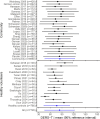Normative reference interval for youths on the Difficulties in Emotion Regulation Scale (DERS)
- PMID: 39749044
- PMCID: PMC11694350
- DOI: 10.2478/sjcapp-2024-0014
Normative reference interval for youths on the Difficulties in Emotion Regulation Scale (DERS)
Abstract
Background: The Difficulties in Emotion Regulation Scale (DERS) is widely used in both clinical and non-clinical research to assess emotional regulation difficulties. To guide interpretation of scores, establishing thresholds for normative DERS scores is informative. However, despite its widespread use, to date no study has provided such threshold for youths. This literature review aimed to fill this gap by examining the 90% reference interval for the DERS in youths aged 11-19 years.
Methods: We conducted a systematic search on PubMed (MEDLINE) on 12 March 2024, to identify studies reporting DERS-36 total scores (DERS-T) in youths aged 11-19 years from either community-based populations or healthy volunteers.
Results: A total of 34 studies were included; 20 studies included community-based participants (n = 6,960), while the remaining 14 studies included healthy volunteers (n = 766), resulting in a total of 7,726 participants. The 90% reference interval for DERS-T from all included participants had a threshold of 121.8 normative emotion regulation in youths.
Conclusion and significance: This threshold is considerably higher than DERS-T scores reported in most clinical studies and a substantial variation in reference intervals across studies is observed. We identify five main methodological factors related to the DERS-36 and discuss their potential impact on the validity, reliability, and generalizability of findings. Given the DERS-T range of 36-180, we conclude that the 90% reference interval derived from our review is not sufficiently robust to guide clinical or scientific interpretations. Our work is not exhaustive, and further research is needed to validate and test the reliability of this reference interval.
Keywords: Emotion regulation; Youths; reference interval; the Difficulties in Emotion Regulation Scale.
© 2024 Christine Lykke Thoustrup et al., published by Sciendo.
Conflict of interest statement
Conflicts of interest The authors declare that they have no conflict of interest.
Figures

Similar articles
-
Drunkorexia and Emotion Regulation and Emotion Regulation Difficulties: The Mediating Effect of Disordered Eating Attitudes.Int J Environ Res Public Health. 2021 Mar 7;18(5):2690. doi: 10.3390/ijerph18052690. Int J Environ Res Public Health. 2021. PMID: 33800011 Free PMC article.
-
Psychometric Properties of the Difficulties in Emotion Regulation Scale (DERS) and Its Short Forms in Adults With Emotional Disorders.Front Psychol. 2018 Apr 19;9:539. doi: 10.3389/fpsyg.2018.00539. eCollection 2018. Front Psychol. 2018. PMID: 29725312 Free PMC article.
-
Development and Validation of a Brief Version of the Difficulties in Emotion Regulation Scale: The DERS-16.J Psychopathol Behav Assess. 2016 Jun;38(2):284-296. doi: 10.1007/s10862-015-9514-x. Epub 2015 Sep 14. J Psychopathol Behav Assess. 2016. PMID: 27239096 Free PMC article.
-
Which Brief Is Best? Clarifying the Use of Three Brief Versions of the Difficulties in Emotion Regulation Scale.J Psychopathol Behav Assess. 2019 Sep 15;41(3):485-494. doi: 10.1007/s10862-019-09736-z. Epub 2019 Apr 22. J Psychopathol Behav Assess. 2019. PMID: 34446987 Free PMC article.
-
Difficulties in emotion regulation in bipolar disorder: A systematic review and meta-analysis.J Affect Disord. 2022 Apr 1;302:352-360. doi: 10.1016/j.jad.2022.01.102. Epub 2022 Jan 29. J Affect Disord. 2022. PMID: 35093412
References
-
- Aldao A, Gee DG, De Los Reyes A, Seager I. Emotion regulation as a transdiagnostic factor in the development of internalizing and externalizing psychopathology: Current and future directions. Dev Psychopathol. 2016 NaN;28:927–46. - PubMed
-
- Gratz KL, Roemer L. Multidimensional Assessment of Emotion Regulation and Dysregulation: Development, Factor Structure, and Initial Validation of the Difficulties in Emotion Regulation Scale. J Psychopathol Behav Assess. 2004;26(1):41–54.
-
- Penner F, Steinberg L, Sharp C. The Development and Validation of the Difficulties in Emotion Regulation Scale-8: Providing Respondents with a Uniform Context That Elicits Thinking About Situations Requiring Emotion Regulation. J Pers Assess. 2023 NaN 3;105(5):657–66. - PubMed
LinkOut - more resources
Full Text Sources
Miscellaneous
